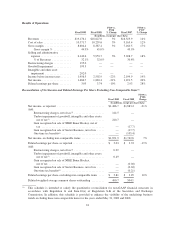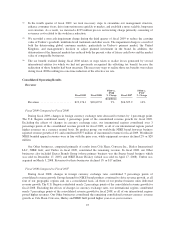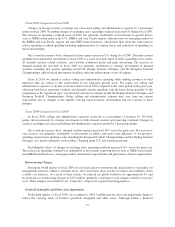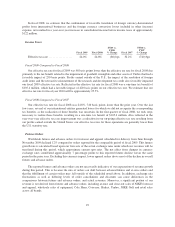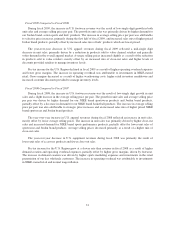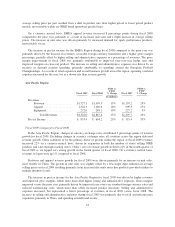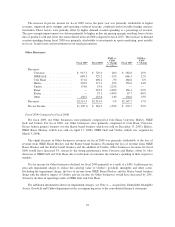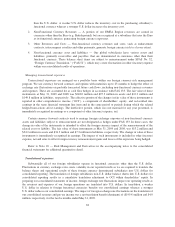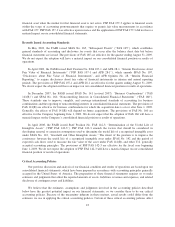Nike 2009 Annual Report Download - page 35
Download and view the complete annual report
Please find page 35 of the 2009 Nike annual report below. You can navigate through the pages in the report by either clicking on the pages listed below, or by using the keyword search tool below to find specific information within the annual report.
average selling price per pair resulted from a shift in product mix from higher priced to lower priced product
models, most notably within our NIKE brand sportswear product lines.
On a currency neutral basis, EMEA apparel revenue increased 8 percentage points during fiscal 2008
compared to the prior year, primarily as a result of increased unit sales and a slight increase in average selling
prices. The increase in unit sales was driven primarily by increased demand for sports performance products,
most notably soccer.
The increase in pre-tax income for the EMEA Region during fiscal 2008 compared to the prior year was
primarily driven by the increase in revenues, favorable foreign currency translation and a higher gross margin
percentage, partially offset by higher selling and administrative expenses as a percentage of revenues. The gross
margin improvement in fiscal 2008 was primarily attributable to improved year-over-year hedge rates and
improved margins on close-out product. The increase in selling and administrative expenses was driven by an
increase in demand creation spending, primarily attributable to spending around the European Football
Championships. As a result of retail expansion and overall business growth across the region, operating overhead
expenses increased for the year, but at a slower rate than revenue growth.
Asia Pacific Region
Fiscal 2009 Fiscal 2008
FY09 vs.
FY08
% Change Fiscal 2007
FY08 vs.
FY07
% Change
(In millions)
Revenues
Footwear ................... $1,727.1 $1,499.5 15% $1,159.2 29%
Apparel .................... 1,322.3 1,140.0 16% 909.3 25%
Equipment .................. 272.6 248.1 10% 227.2 9%
Total Revenues .......... $3,322.0 $2,887.6 15% $2,295.7 26%
Pre-tax Income .................. $ 853.4 $ 694.2 23% $ 515.4 35%
Fiscal 2009 Compared to Fiscal 2008
In the Asia Pacific Region, changes in currency exchange rates contributed 3 percentage points of revenue
growth for fiscal 2009. Excluding changes in currency exchange rates, all countries across the region delivered
revenue growth. China continues to be the primary driver of growth within the region as fiscal 2009 revenues
increased 22% on a currency-neutral basis, driven by expansion in both the number of stores selling NIKE
products and sales through existing stores. China’s rate of revenue growth slowed to 6% in the fourth quarter of
fiscal 2009 as we lapped very strong growth in the fourth quarter of fiscal 2008. On a currency neutral basis,
revenues in Japan were up 1% compared to fiscal 2008.
Footwear and apparel revenue growth for fiscal 2009 were driven primarily by an increase in unit sales,
most notably in China. The growth in unit sales was slightly offset by a low-single digit reduction in average
selling prices in fiscal 2009 resulting primarily from increased discounts on in-line products provided retailers to
manage inventory levels.
The increase in pre-tax income for the Asia Pacific Region for fiscal 2009 was driven by higher revenues
and improved gross margins, which more than offset higher selling and administrative expenses. Gross margins
improved versus the prior year, primarily driven by improved year-over-year standard foreign currency rates and
reduced warehousing costs, which more than offset increased product discounts. Selling and administrative
expenses increased, but represented a lower percentage of revenues in fiscal 2009 versus fiscal 2008. The
increase in selling and administrative expenses during fiscal 2009 was primarily due to retail and infrastructure
expansion, primarily in China, and spending around brand events.
33



